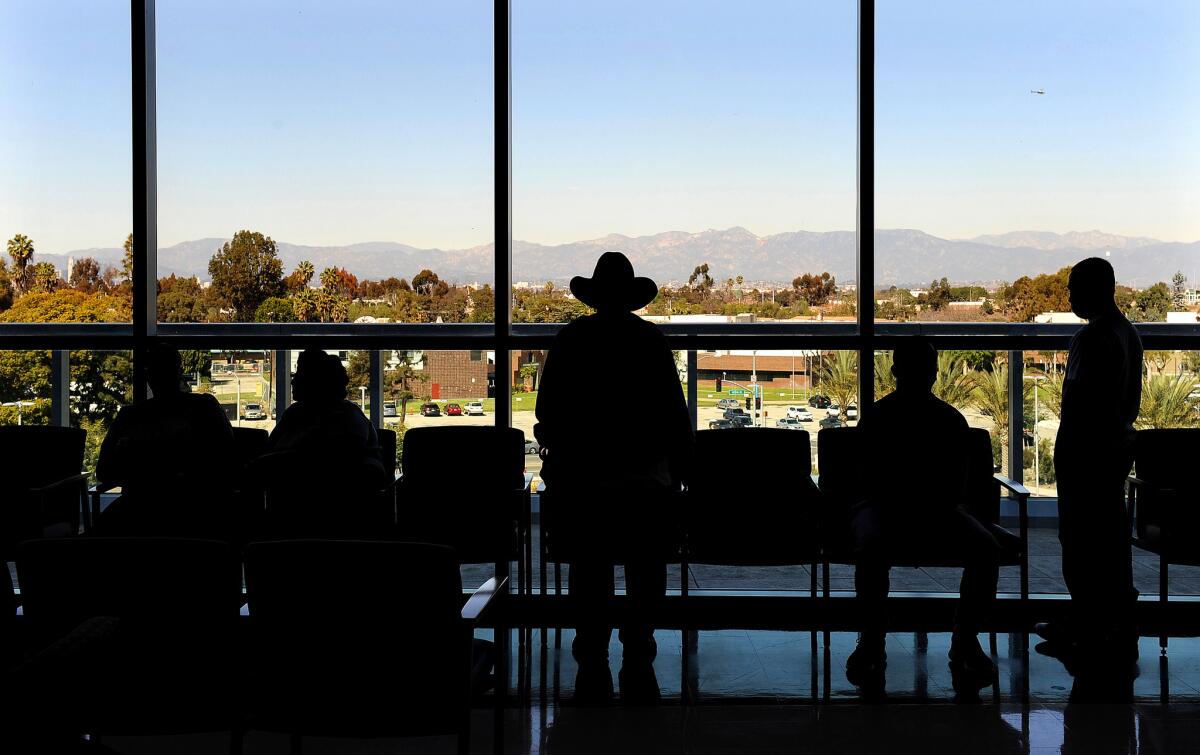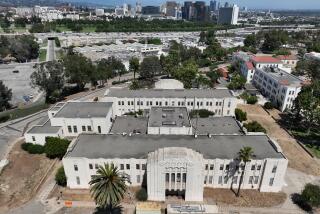South L.A.’s MLK hospital will reopen with a new healthcare outlook

The new Martin Luther King, Jr. Community Hospital doesn’t open until June, but that’s hard to tell with all the people darting in and out of buildings at the South Los Angeles medical facility.
On a recent morning, a doctor crosses the 42-acre campus with a briefcase slung over his shoulder. A patient with a cane hobbles down a path. People in scrubs grab food from a taco truck.
“This place has a heartbeat,” says Dr. Mark Ghaly, deputy director for community health and integrated programs for the Los Angeles County Department of Health Services. “The heartbeat is not the hospital.”
The focus of medical care, Ghaly argues, has shifted away from hospitals.
And with its emphasis on preventive treatments, with its new urgent-care center and outpatient and public health clinics, the new MLK campus, he says, provides a state-of-the-art answer to the question: How do you build a hospital in 2015?
Or, as others put it, how do you build a hospital for the era of Obamacare?
The hospital now known as MLK opened in 1972, with people in the largely black Willowbrook neighborhood celebrating it as symbol of the civil rights movement’s success. But the last time “Killer King” made national news was in 2007, when a woman died writhing on the floor of the emergency room lobby and a janitor mopped around her as she vomited.
That incident followed years of complaints about poor treatment, and federal regulators ultimately forced the hospital to shut down.
Since then, people in South L.A. have watched as money delays and bureaucratic setbacks stalled the hospital’s reopening. With a life-and-death stake in what comes next, some are skeptical of any plan that doesn’t prioritize lots of beds — a concern shared by Jennifer Bayer of the Hospital Assn. of Southern California, who notes that whereas the nationwide ratio of beds per resident of a region is three per 1,000, this region has just one per thousand.
Bridgitte Brewington, 35, says that sometimes her acute bronchial spasms are so bad she can’t walk. The other facilities on the MLK campus are important, she says, but the hospital itself is vital.
Douglas Bloxton, 49, has a similar view. He lives near the hospital and had several emergency surgeries at MLK. He points to scars where physicians removed two bullets from his legs. MLK surgeons later put pins in his hip after a car accident. “Martin Luther King took care of me,” he says. “We need that hospital open.”
Although no one advocates that the hospital not reopen, supporters of the MLK approach note that in the eight years since the hospital closed, the healthcare landscape has changed dramatically.
The new MLK hospital — housed in a tower of the old hospital building — has 131 beds, compared with more than 450 when the hospital was at its largest. The emergency room no longer has a trauma center, and the hospital offers fewer medical specialties than before.
The people who planned the new campus, and other heathcare experts, say this aligns with the latest thinking of how to provide care.
The Affordable Care Act, passed in 2010, embraces the idea of reducing costly hospital visits by keeping people healthy, with checkups and inexpensive preventive treatments. Hospitals, according to this approach, should not be the centerpiece of a medical system, but rather the solution of last resort.
They should, in short, be smaller.
“Before, they just built a lot of beds and hoped for the best,” said David Belson, a USC engineering professor and expert in hospital efficiency. He said hospital administrators nationwide are now smarter about finding the most cost-effective and appropriate ways to see patients, which often means not admitting them to the hospital.
Between 2008 and 2012 several indicators of inpatient stays in California hospitals dropped: the number of patients admitted, the length of stay and the occupancy rate.
“Healthcare delivery systems today are not what they were a quarter of a century ago,” says county Supervisor Mark Ridley-Thomas, who worked to reopen the facilities. Ridley-Thomas says the new campus, which is in his district, offers “a constellation of services that keep people well.”
Those new facilities, says Ghaly, opened one-by-one over the last eight years, as county officials dreamed up different ways to invest in the campus.
County officials realized, for example, that many of the patients who used to visit MLK’S emergency room came in for psychiatric illnesses, so they opened an urgent-care psychiatric center last year. There’s also an expanded outpatient clinic and a public health center where patients can get such services as immunizations and STD testing.
A recuperative care facility — for patients who need a long-term place to recover from an illness — is set to open in the fall. The old hospital building, currently vacant, will also probably become an ancillary facility.
The minds behind the MLK plan didn’t necessarily set out to build the medical campus of the future, Ghaly says. But with all the people invested in revamping the facility, “it just kind of happened that way.”
Belson says that nationwide, the administrators who are reimagining hospitals are focused on efficiency as never before. “It’s not just L.A. or Martin Luther King by any means,” he says.
Under changes outlined by the Affordable Care Act, hospitals and doctors’ payments are based more on keeping patients healthy. For instance, providers are paid a lump sum to take care of a patient over a period of time, so they profit when they prevent patients from getting sick, avoiding expensive care.
In a sign of the growing shift away from the traditional fee-for-service model, federal officials announced in January that Medicare, the government’s biggest health insurance program, would handle half its payments based on quality of care by 2018.
Ghaly views the MLK campus as a set of concentric circles, with the hospital in the center. The facilities around the hospital are buffers sparing people the experience of spending a night amid blood-filled tubes and beeping monitors.
If you end up hospitalized, he says, “you have to be too sick for outpatient services, too sick for the preventative services, too sick for the community-based services.”
“We want the hospital to be ... high-quality, safe and patient-centered,” he says. “But, truly, we want no one to go.”
Ridley-Thomas says he’s proud that the once-troubled campus is serving patients again. “It’s not often the case that distressed public hospitals reopen, and they certainly don’t reopen in this manner.”
For his part, T.C. Jones, 75, isn’t really concerned about healthcare theories, payment models or bed counts. He remembers how bad the hospital used to be, he says. He’s seen bedridden patients lined up in the hallways.
What he wants to know about the new MLK is this: Will it be good?
Follow @skarlamangla on Twitter for more L.A. health news.
More to Read
Sign up for Essential California
The most important California stories and recommendations in your inbox every morning.
You may occasionally receive promotional content from the Los Angeles Times.











